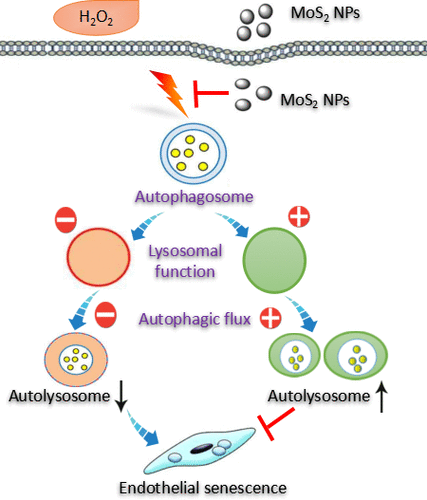当前位置:
X-MOL 学术
›
ACS Biomater. Sci. Eng.
›
论文详情
Our official English website, www.x-mol.net, welcomes your
feedback! (Note: you will need to create a separate account there.)
Molybdenum Disulfide Nanoparticles Resist Oxidative Stress-Mediated Impairment of Autophagic Flux and Mitigate Endothelial Cell Senescence and Angiogenic Dysfunctions
ACS Biomaterials Science & Engineering ( IF 5.4 ) Pub Date : 2018-01-03 00:00:00 , DOI: 10.1021/acsbiomaterials.7b00714 Sunkui Ke 1 , Youlin Lai 2 , Tong Zhou 3 , Lihuang Li 3 , Yange Wang 3 , Lei Ren 3 , Shefang Ye 3
ACS Biomaterials Science & Engineering ( IF 5.4 ) Pub Date : 2018-01-03 00:00:00 , DOI: 10.1021/acsbiomaterials.7b00714 Sunkui Ke 1 , Youlin Lai 2 , Tong Zhou 3 , Lihuang Li 3 , Yange Wang 3 , Lei Ren 3 , Shefang Ye 3
Affiliation

|
The impairment of autophagy involves oxidative stress-induced cellular senescence, leading to endothelial dysfunctions and the onset of cardiovascular diseases. As molybdenum disulfide nanoparticles (MoS2 NPs), representative transition metal dichacogenide materials, have great potential as a multifunctional therapeutic agent against various disorders, the present study aimed to investigate whether MoS2 NPs prevents hydrogen peroxide (H2O2)-induced endothelial senescence by modulating autophagic process. Our results showed that pretreatment with MoS2 NPs inhibited H2O2-induced endothelial senescence and improved endothelial functions. Exposure of H2O2 increased p62 level and blocked the fusion of autophagosomes with lysosomes, indicating of impaired autophagic flux in senescent endothelial cells. However, MoS2 NPs pretreatment efficiently suppressed cellular senescence through triggering autophagy and resisting impaired autophagic flux. Furthermore, the genetic inhibition of autophagy by siRNA against Beclin 1 or ATG-5 directly abrogated the protective action of MoS2 NPs on endothelial cells against H2O2-induced senescence.Thus, these results suggested that MoS2 NPs rescue endothelial cells from H2O2-induced senescence by improving autophagic flux, and provide valuable information for the rational design of MoS2-based nanomaterials for therapeutic use in senescence-related diseases.
中文翻译:

二硫化钼纳米粒子抗氧化应激介导的自噬通量的损害和减轻内皮细胞衰老和血管生成功能障碍。
自噬的损害涉及氧化应激诱导的细胞衰老,导致内皮功能障碍和心血管疾病的发作。由于二硫化钼纳米颗粒(MoS 2 NPs)是代表性的过渡金属二硫化碳材料,具有作为针对多种疾病的多功能治疗剂的巨大潜力,因此本研究旨在研究MoS 2 NPs是否能防止过氧化氢(H 2 O 2)诱导的内皮细胞通过调节自噬过程实现衰老。我们的结果表明,用MoS 2 NPs进行预处理可抑制H 2 O 2诱导的内皮细胞衰老并改善内皮细胞功能。H的暴露2 O 2增加p62水平并阻止自噬小体与溶酶体融合,表明衰老的内皮细胞自噬通量受损。但是,MoS 2 NPs预处理通过触发自噬和抵抗受损的自噬通量来有效抑制细胞衰老。此外,siRNA对Beclin 1或ATG-5自噬的遗传抑制作用直接废除了MoS 2 NPs对内皮细胞抵抗H 2 O 2诱导的衰老的保护作用。因此,这些结果表明MoS 2 NPs可从内皮细胞中拯救内皮细胞。 H 2 O 2通过改善自噬通量而诱导衰老,并为用于与衰老相关的疾病的治疗用途的基于MoS 2的纳米材料的合理设计提供有价值的信息。
更新日期:2018-01-03
中文翻译:

二硫化钼纳米粒子抗氧化应激介导的自噬通量的损害和减轻内皮细胞衰老和血管生成功能障碍。
自噬的损害涉及氧化应激诱导的细胞衰老,导致内皮功能障碍和心血管疾病的发作。由于二硫化钼纳米颗粒(MoS 2 NPs)是代表性的过渡金属二硫化碳材料,具有作为针对多种疾病的多功能治疗剂的巨大潜力,因此本研究旨在研究MoS 2 NPs是否能防止过氧化氢(H 2 O 2)诱导的内皮细胞通过调节自噬过程实现衰老。我们的结果表明,用MoS 2 NPs进行预处理可抑制H 2 O 2诱导的内皮细胞衰老并改善内皮细胞功能。H的暴露2 O 2增加p62水平并阻止自噬小体与溶酶体融合,表明衰老的内皮细胞自噬通量受损。但是,MoS 2 NPs预处理通过触发自噬和抵抗受损的自噬通量来有效抑制细胞衰老。此外,siRNA对Beclin 1或ATG-5自噬的遗传抑制作用直接废除了MoS 2 NPs对内皮细胞抵抗H 2 O 2诱导的衰老的保护作用。因此,这些结果表明MoS 2 NPs可从内皮细胞中拯救内皮细胞。 H 2 O 2通过改善自噬通量而诱导衰老,并为用于与衰老相关的疾病的治疗用途的基于MoS 2的纳米材料的合理设计提供有价值的信息。










































 京公网安备 11010802027423号
京公网安备 11010802027423号